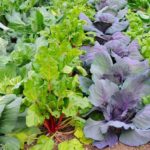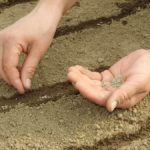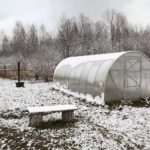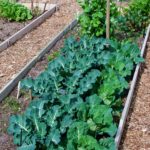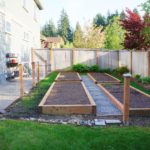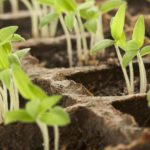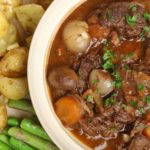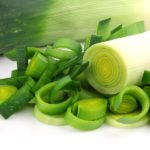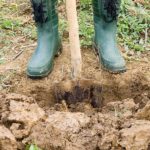February is a busy month for the vegetable gardener. In many regions, indoor and outdoor sowing and planting will begin. Gardeners in warm regions already have seed in the ground. In cold regions, where there is snow on the ground, February is still time for making plans and preparing for spring.
Here are some tips for things you can do in February to get your garden growing.
 Warm Region Vegetable Garden Tips: Zones 9 and 10
Warm Region Vegetable Garden Tips: Zones 9 and 10
In warm-winter regions, you can begin planting both cool- and warm-season vegetables and herbs in February. Plant asparagus, beets, beans, cabbage, carrots, kale, lettuce, onions, onion sets, parsley, parsnip, peas, potatoes, radishes, and salsify. Start indoors corn, cucumbers, eggplant, melons, okra, pumpkin, squash, and tomatoes. USDA Zones 9 and 10 in the United States include much of the Gulf and South Atlantic Coasts, Florida, parts of the Pacific Southwest and Desert states, and the California Coast from the Bay Area south. Continue reading >>>
 Cool Region Vegetable Garden Tips: Zone 8
Cool Region Vegetable Garden Tips: Zone 8
Prepare your garden soil for planting by spading when the ground is not wet. Complete orders for seeds and supplies as soon as possible. When the weather begins to warm and nighttime temperatures no longer dip into the 30sF, plant outdoors early vegetables: beets, cabbage (seedlings), carrots, cauliflower (seedlings), chard, lettuce, mustard, onions (sets or seedlings), peas, potatoes, salsify, spinach, and turnips. You can start tomato, pepper, and eggplant seeds indoors in February. It will take 7 to 8 weeks to grow plants large enough to transplant to the garden. USDA Zone 8 in the United States includes Mid-South and Pacific Northwest states. Continue reading>>>
 Cold Region Vegetable Garden Tips: Zones 3, 4, 5, 6, 7
Cold Region Vegetable Garden Tips: Zones 3, 4, 5, 6, 7
Begin sowing cool-season vegetables and herbs indoors in flats and small pots during February for transplanting into the garden when the snow has melted. Cool-season vegetables include cabbage, cauliflower, celery, Brussels sprouts, and broccoli. Also in February, most fruits, including pears, plums, apples, and bush fruits such as gooseberries and currants should be pruned on any days that it are not freezing. USDA Zones, 3, 4, 5, 6, and 7 include the Northeast, Upper Midwest, Plains, and Rocky Mountain states and Canada. Continue reading>>>
 Best Cool-Season Vegetable Varieties for Spring Planting
Best Cool-Season Vegetable Varieties for Spring Planting
Here’s a list of proven cool-weather vegetable crop varieties to plant this spring. Print this list and take it to the garden center or seed store. If you want planting tips for any of these crops, check out the Topics Index under the crop name. Continue reading>>>
 How to Start a Vegetable Garden for Beginners
How to Start a Vegetable Garden for Beginners
The secret to getting started vegetable gardening is to take a little time to make a plan. Take a look at your yard, patio, balcony, or front stoop, think about what you’d like to grow, make a list of the veggies you like to eat, talk to the staff at a local nursery or garden center, and talk to friends and neighbors with experience. Continue reading >>>
 Early Planting Onions and Garlic
Early Planting Onions and Garlic
Plant sets of garlic, onions, and shallots early in spring to get large bulbs at harvest. Start indoors garlic, onions and shallots where snow or too much rain keeps you out of the garden early in the season. Garlic, onion, and shallot transplants started indoors are the quickest way to produce a crop. Continue reading>>>
 Starting the Spring Vegetable Garden Indoors
Starting the Spring Vegetable Garden Indoors
Snow on the ground? Heavy winter rain in the garden? Last average frost date weeks away? No problem. You can start the spring vegetable garden indoors. If you know the average date of the last spring frost in your garden or region, you can simply count backward the number of days and weeks needed to begin starting seeds indoors. Here’s exactly what you need to know to get started. Continue reading>>>
 Beef and Winter Vegetables Slow Cooked
Beef and Winter Vegetables Slow Cooked
Here’s the recipe for a hearty and tasty winter vegetable-loaded beef stew for the slow cooker. You can vary the root vegetables in this stew—choose from carrots, turnips, parsnips, new potatoes, onions, or leeks and add mushrooms or celery. The combinations are many. Continue reading >>>
 Leeks: Kitchen Basics
Leeks: Kitchen Basics
The most esteemed member of the onion family is the leek. The flavor and fragrance of leeks are more subtle, more delicate, and sweeter than onions. The leek is essential to many fine dishes—the popular cold soup vichyssoise—which has been made in France for centuries, the Scottish cock-a-leekie, and stews such as the French pot-au-feu. Overwintered and winter-grown leeks come to harvest in spring. Learn quick and easy ways to cook leeks. Continue reading >>>
 Carrots: Kitchen Basics
Carrots: Kitchen Basics
Tiny carrots steamed whole in butter; young carrots glazed in honey syrup; half-grown carrots served fresh from the garden: carrots need not be taken for granted. The key to serving the best, tasty carrots are freshly harvested carrots not too small and not too large. Here are some easy ways to cook carrots. Continue reading>>>
 Summer’s End in the Southern Hemisphere
Summer’s End in the Southern Hemisphere
February is late summer in the Southern Hemisphere. Autumn will come officially to Australia, New Zealand, South Africa, Argentina, Uruguay, and Chile on March 21. Harvesting is in full swing in the February summer garden. Lift onions and dry them in the sun before storing them. Continue to pick beans, courgettes, squash, and tomatoes as they ripen. Harvest these as they ripen and less mature crops still on the vine will ripen more quickly. Continue reading>>>
 Old-Time Garden Wisdom
Old-Time Garden Wisdom
What gets bigger the more you take away?
Answer: A hole.


